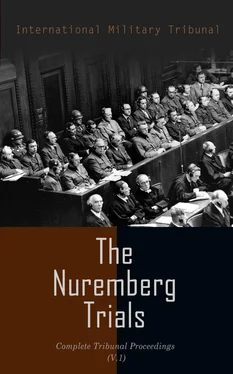(G) WANTON DESTRUCTION OF CITIES, TOWNS, AND
VILLAGES AND DEVASTATION NOT JUSTIFIED BY
MILITARY NECESSITY
The defendants wantonly destroyed cities, towns, and villages and committed other acts of devastation without military justification or necessity. These acts violated Articles 46 and 50 of the Hague Regulations, 1907, the laws and customs of war, the general principles of criminal law as derived from the criminal laws of all civilized nations, the internal penal laws of the countries in which such crimes were committed, and Article 6 (b) of the Charter.
Particulars by way of example only and without prejudice to the production of evidence of other cases are as follows:
1. Western Countries:
In March 1941, part of Lofoten in Norway was destroyed.
In April 1942, the town of Telerag in Norway was destroyed.
Entire villages were destroyed in France, among others Oradour-sur-Glane, Saint-Nizier and, in the Vercors, La Mure, Vassieux, La Chapelle en Vercors. The town of Saint Dié was burnt down and destroyed. The Old Port District of Marseilles was dynamited in the beginning of 1943 and resorts along the Atlantic and the Mediterranean coasts, particularly the town of Sanary, were demolished.
In Holland there was most widespread and extensive destruction, not justified by military necessity, including the destruction of harbors, locks, dikes, and bridges: immense devastation was also caused by inundations which equally were not justified by military necessity.
2. Eastern Countries:
In the Eastern Countries the defendants pursued a policy of wanton destruction and devastation: some particulars of this (without prejudice to the production of evidence of other cases) are set out above under the heading “Plunder of Public and Private Property”.
In Greece the villages of Amelofito, Kliston, Kizonia, Messovunos, Selli, Ano-Kerzilion, and Kato-Kerzilion were utterly destroyed.
In Yugoslavia on 15 August 1941, the German military command officially announced that the village of Skela was burned to the ground and the inhabitants killed on the order of the command.
On the order of the Field Commander Hoersterberg a punitive expedition from the SS troops and the field police destroyed the villages of Machkovats, and Kriva Reka in Serbia and all the inhabitants were killed.
General Fritz Neidhold (369 Infantry Division) on 11 September 1944, gave an order to destroy the villages of Zagniezde and Udora, hanging all the men and driving away all the women and children.
In Czechoslovakia the Nazi conspirators also practiced the senseless destruction of populated places. Lezaky and Lidice were burned to the ground and the inhabitants killed.
(H) CONSCRIPTION OF CIVILIAN LABOR
Throughout the occupied territories the defendants conscripted and forced the inhabitants to labor and requisitioned their services for purposes other than meeting the needs of the armies of occupation and to an extent far out of proportion to the resources of the countries involved. All the civilians so conscripted were forced to work for the German war effort. Civilians were required to register and many of those who registered were forced to join the Todt Organization and the Speer Legion, both of which were semi-military organizations involving some military training. These acts violated Articles 46 and 52 of the Hague Regulations, 1907, the laws and customs of war, the general principles of criminal law as derived from the criminal laws of all civilized nations, the internal penal laws of the countries in which such crimes were committed, and Article 6 (b) of the Charter.
Particulars, by way of example only and without prejudice to the production of evidence of other cases, are as follows:
1. Western Countries:
In France, from 1942 to 1944, 963,813 persons were compelled to work in Germany and 737,000 to work in France for the German Army.
In Luxembourg in 1944 alone, 2,500 men and 500 girls were conscripted for forced labor.
2. Eastern Countries:
Of the large number of citizens of the Soviet Union and of Czechoslovakia referred to under Count Three VIII (B) 2 above many were so conscripted for forced labor.
(I) FORCING CIVILIANS OF OCCUPIED TERRITORIES TO
SWEAR ALLEGIANCE TO A HOSTILE POWER
Civilians who joined the Speer Legion, as set forth in paragraph (H) above, were required, under threat of depriving them of food, money, and identity papers, to swear a solemn oath acknowledging unconditional obedience to Adolf Hitler, the Führer of Germany, which was to them a hostile power.
In Lorraine, civil servants were obliged, in order to retain their positions, to sign a declaration by which they acknowledged the “return of their country to the Reich”, pledged themselves to obey without reservation the orders of their chiefs and put themselves “at the active service of the Führer and the Great National Socialist Germany”.
A similar pledge was imposed on Alsatian civil servants by threat of deportation or internment.
These acts violated Article 45 of the Hague Regulations, 1907, the laws and customs of war, the general principles of international law, and Article 6 (b) of the Charter.
(J) GERMANIZATION OF OCCUPIED TERRITORIES
In certain occupied territories purportedly annexed to Germany the defendants methodically and pursuant to plan endeavored to assimilate those territories politically, culturally, socially, and economically into the German Reich. The defendants endeavored to obliterate the former national character of these territories. In pursuance of these plans and endeavors, the defendants forcibly deported inhabitants who were predominantly non-German and introduced thousands of German colonists.
This plan included economic domination, physical conquest, installation of puppet governments, purported de jure annexation and enforced conscription into the German Armed Forces.
This was carried out in most of the occupied countries including: Norway, France (particularly in the Departments of Upper Rhine, Lower Rhine, Moselle, Ardennes, Aisne, Nord, Meurthe and Moselle), Luxembourg, the Soviet Union, Denmark, Belgium, and Holland.
In France in the Departments of Aisne, Nord, Meurthe and Moselle, and especially in that of Ardennes, rural properties were seized by a German state organization which tried to have them exploited under German direction; the landowners of these exploitations were dispossessed and turned into agricultural laborers.
In the Department of Upper Rhine, Lower Rhine, and Moselle, the methods of Germanization were those of annexation followed by conscription.
1. From the month of August 1940, officials who refused to take the oath of allegiance to the Reich were expelled. On 21 September expulsions and deportation of populations began and on 22 November 1940, more than 70,000 Lorrainers or Alsatians were driven into the south zone of France. From 31 July 1941 onwards, more than 100,000 persons were deported into the eastern regions of the Reich or to Poland. All the property of the deportees or expelled persons was confiscated. At the same time, 80,000 Germans coming from the Saar or from Westphalia were installed in Lorraine and 2,000 farms belonging to French people were transferred to Germans.
2. From 2 January 1942, all the young people of the Departments of Upper Rhine and Lower Rhine, aged from 10 to 18 years, were incorporated in the Hitler Youth. The same thing was done in Moselle from 4 August 1942. From 1940 all the French schools were closed, their staffs expelled, and the German school system was introduced in the three Departments.
3. On the 28 September 1940, an order applicable to the Department of Moselle ordained the Germanization of all the surnames and Christian names which were French in form. The same thing was done from 15 January 1943, in the Departments of Upper Rhine and Lower Rhine.
Читать дальше












